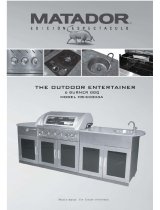Should you have difficulty in lighting your barbecue while following these instructions, please turn OFF all burners
and the gas supply, and contact your store of purchase for advice.
Once alight, the burner control knob can be adjusted anywhere between HI and LOW to adjust the heat level.
On HI, the burner flame should be 12-20mm long with a minimum of yellow tipping.
After lighting, observe the burner flame and make sure all burner ports are lit.
If a burner flame goes out during operation, immediately turn the gas cylinder valve clockwise to OFF. Turn all
control knobs clockwise to OFF. Open the BBQ hood and side burner lid to let the gas clear for about 5 minutes
before re-lighting.
SHUTTING DOWN:
Normally, when you've finished cooking, it's a good idea to leave the burner controls on HI with the hood open for a
maximum of 5 minutes to burn off excess grease from the flame tamer, the burner, and other surfaces.
To shut the barbeque down, it is best to turn OFF at the cylinder first and allow all the gas left in the hose to burn off.
This will only take a couple of seconds. Then turn OFF all burner’s controls. If your barbeque is connected to piped
gas, you can simply turn the burner controls OFF. It is okay to leave the cylinder connected to your barbeque while
it's not in use, though you must ensure all barbeque and cylinder valves are OFF.
PREPARING THE COOKING SURFACES:
Before cooking on your barbeque for the first time, it is important that you clean off any residues which may be left
over from manufacturing, storage, and transport.
Before first use, clean the cooking surface with warm soapy water and a sponge. Thoroughly rinse with fresh water.
Dry the cooking surface, then lightly coat it with Bar-B-Chef Non-Stick Barbeque Cooking Spray.
PRE HEATING THE BBQ:
After the main burner(s) are lit, allow the burners run on HI for 3-5 minutes to pre-heat before starting to cook. This
should be done before each cooking session. The hood should be closed when pre-heating. With the hood closed, the
burners need to be turned to LOW after 5 minutes to avoid overheating the BBQ.
CONTROLLING THE HEAT:
There are a number of ways to control the heat to achieve different cooking results.
It is important not to overheat the BBQ as that could be dangerous and will not give you good cooking results.
• The burner control knobs can be individually adjusted anywhere between HI and LOW to adjust the heat level
and heat distribution.
• Individual burners can be turned OFF to adjust the heat level and heat distribution.
• Food to be cooked on the grills and optional hotplate can be positioned directly above burners at different settings
to achieve different results.
• The hood can be open or closed during cooking which significantly affects cooking temperatures.
• Food can be positioned to avoid direct heat on the warming rack, in optional roasting racks and roasting pans.
• Note that when burners are on under the optional hotplate, that the excess convection heat from those burners will
spill out under the adjacent cooking grill(s), adding heat to those grills close to the hotplate.





















